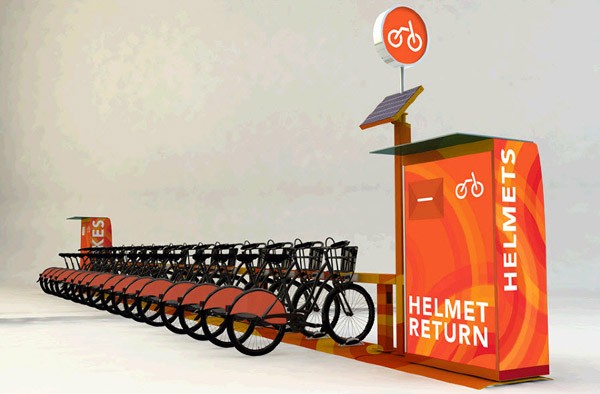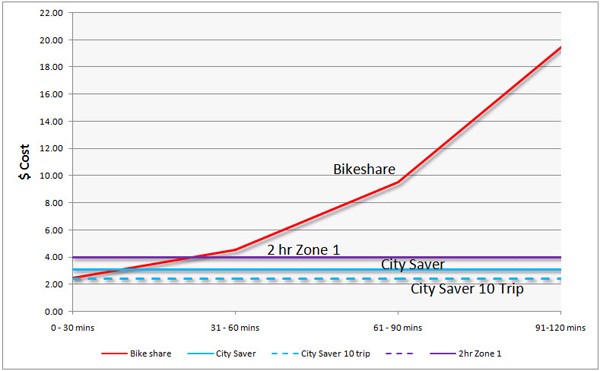
It’s not surprising Vancouver is dragging its feet on implementing the city’s promised bikeshare scheme – it’s one of the few major cities in the world with a law mandating the wearing of helmets by adults. There seems to be good reason for Vancouver to be nervous: the available evidence indicates bikeshare has failed in the only three cities its been tried in where helmets are compulsory i.e. Auckland, Brisbane and Melbourne.
These failures prompted a vigorous campaign in Australia and New Zealand for the repeal of mandatory helmet laws. The aim of advocates extends well beyond the welfare of Australasia’s ailing bikeshare schemes – most want the wearing of helmets to be made a matter of individual choice for all adult cyclists.
New figures released this week show usage of Melbourne Bike Share’s (MBS) blue Bixis reached a record high in January. Still, the performance is poor. On average, each Bixi only gets hired once per day. No data on typical hire times was made available but the pattern in other countries suggests each Bixi is used for less than 30 minutes per day on average.
The argument that the mandatory helmet law is the main reason bikeshare has failed in Australasia seems compelling. However while it is undoubtedly an important factor, it might not be the only one and it might not even be the most important one. It doesn’t automatically follow that, were MBS (say) given an exemption from the helmet law, the scheme would be a resounding success.
There are reasons to avoid rushing to judgement and I want to look at them using MBS as a case study. One reason I’m cautious is access to helmets has much improved since MBS began.
The Government now subsidises the cost of helmets and makes them available at hotels and a range of outlets near MBS stations for $5 (in Brisbane, the City Council made 400 free helmets available on an honesty basis). Unfortunately helmets are mostly not available at the point of hire. Some observers point out that’s unfriendly to tourists, but MBS isn’t pitched at tourists – it’s explicitly aimed directly at inner city workers and residents.
After 18 months operation, I reckon any Melburnian who’s likely to be a serious and consistent user of Bixis has had ample time to put a $5 helmet in their desk drawer or hang a couple near the door of their apartment.
Some argue that having to seek out a helmet from a nearby convenience store works against spontaneous trips. Availability at point of sale would of course be better, but I doubt many trips are so spontaneous they’re made in the street on the spur of the moment. Meetings, interviews, dates, lunches, shows, etc are almost always made with at least some notice. People imagine they’d make impulsive trips on Bixis but in practice make few unplanned trips. Frankly, I wonder if truly “spontaneous” trips are valuable enough to warrant the subsidy the government provides for MBS.
I think many observers implicitly compare MBS with the most successful schemes elsewhere, especially Paris’s Vélib‘, and imagine that’s what Melbourne would be like if it weren’t for the helmet law. But like almost everything, there is immense variability between cities and countries. We should expect some cities do much better than the average and some do much worse. The absence of mandatory helmet laws doesn’t guarantee bikeshare would be a huge, or even modest, success in all cities.
I haven’t seen a reliable comparative analysis of the performance of the various bikeshare schemes across the globe, but I know that overall cycling rates vary enormously by country and city. For example, cycling accounts for 27% of all trips in the Netherlands but only 1% in the UK. Neither country has mandatory helmet laws so there must be other variables at play.
Or consider differences between individual cities in Europe – cycling accounts for 20% of all trips in Bruges but 5% in Brussels; 19% in Salzburg but 3% in Wien; 37% in Groningen but 10% in Heerlen. Helmets have nothing to do with these large within-country variations.
There is a range of other factors, both “exogenous” and “endogenous”, that are likely to affect the demand for bikeshare. The sheer unfriendliness of our roads for cycling is in the former class. Streets in Australian cities do not feel safe for cycling and many drivers are aggressive and intolerant of cyclists. Notwithstanding the intensity of pedestrian activity, the speed limit in Melbourne’s CBD is still 50 kmh.
Melbourne has a wonderful system of recreational cycling paths along water courses, but very few kilometres of segregated bicycle lane suitable for the sorts of purpose-driven trips (i.e. for transport rather than recreation) MBS is aimed at. The city also lacks the pro-bicycle history and culture underpinning the success of cycling in Europe. Melburnians aren’t confident cycling on roads and aren’t used to doing it.
A related factor is that many of those who are confident enough to cycle on roads may already have their own bikes in their apartments or in the basement of their office buildings. And perhaps the need for Bixis is not as compelling as many assume. The CBD and its outer edges are already very well served by public transport. It might be that trams and trains provide a more attractive offer than Bixis for many journeys.
There are also some endogenous factors that might limit demand for MBS. As I noted above, the scheme spurns tourists, who are a huge market in some other places. The design of the tariff favours short duration trips and positively deters tourists who want to spend half a day or more touring the city (see second exhibit, below).
MBS also has a relatively sparse network with only 50 bike stations. If there are no stations near a destination to dock the Bixi, then a prospective hirer won’t bother – she’ll walk or take a tram instead. The way the scheme is managed can also be an issue – even if there’s a station at the trip end, the would-be hirer has to be confident there’ll be a spare place to dock the bike. A lot of the stations I’ve seen have few spare spots (this might be a vicious cycle).
Thus helmets aren’t the only factor negatively affecting the demand for MBS. Nor does the failure of MBS necessarily mean the current law on helmets is a bad thing. It would be absurd to repeal the law simply to get bikeshare working – whether you agree with it or not, the issues surrounding the law are much bigger than whether bikeshare lives or dies.
The key failure of MBS vis-a-vis helmets is that it didn’t address from the get-go how the law would be managed. As the first exhibit shows, one of the options under consideration for Vancouver addresses this issue directly.
There’s every indication political imperatives drove MBS and it was set up without proper analysis. But it would send a bad message for cycling generally if the scheme were to fail. It’s therefore very important that some real effort is put into understanding the key drivers of success rather than assuming there’s a single obvious cause of its poor performance to date. That sort of blind thinking is why the issues were never properly considered from the outset.








Crikey is committed to hosting lively discussions. Help us keep the conversation useful, interesting and welcoming. We aim to publish comments quickly in the interest of promoting robust conversation, but we’re a small team and we deploy filters to protect against legal risk. Occasionally your comment may be held up while we review, but we’re working as fast as we can to keep the conversation rolling.
The Crikey comment section is members-only content. Please subscribe to leave a comment.
The Crikey comment section is members-only content. Please login to leave a comment.